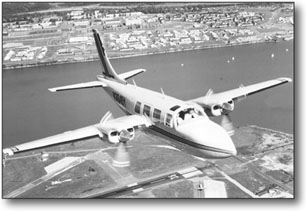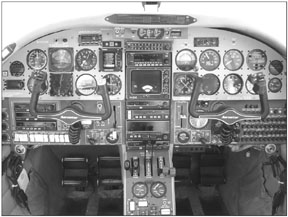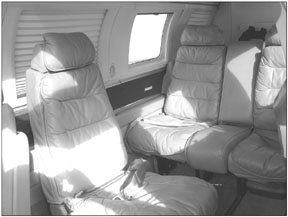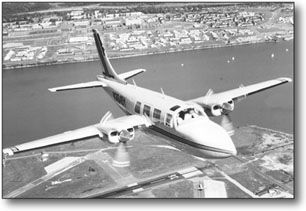
The Aerostar is one of the few airplanes that occupies black-and-white polar opposites. Its cheaper to buy than a decent mid-1980s Bonanza and will leave the Bo-and about everything else-sucking propwash, speedwise.
The piper to be paid, however, is high cost of operation. The Aerostar burns fuel prodigiously-although it doesnt have to-and owners say that if you cant afford regular and often expensive maintenance, don’t even think about an Aerostar. But if all you think about is speed, this flashy twin may be the only choice.
History
The Aerostar is the product of famed aircraft designer Ted Smith, whose name is attached to such classics as the A-20 twin-engine bomber and the Twin and Jet Commander lines. In 1963, Smith formed his own company to build a family of fast fliers, all built around the same fuselage, wings and tail.
Five years later, the Model 600 emerged in 1968, with normally aspirated Lycoming IO-540 engines and a takeoff weight of 5500 pounds. A year later, the 601 appeared, with a pair of Rajay turbochargers and manually controlled, electrically actuated wastegates on each engine. With turbos, the engines could maintain 290 horsepower from sea level to 16,000 feet.
By this point, Smith had sold out, first to American Cement and later to Butler Aviation, which acquired both Aerostar and Mooney and moved them to Kerrville, Texas. A squabble between the new owner and the old over corrosion idled the line for two years. Unwilling to let his idea wither, Ted Smith organized a group of investors and bought the company back, setting it up in Santa Maria, California. The new company began building the 600A and 601A in 1973. The A models had Lycomings with heavier crankcases and crankshafts and engine TBO was boosted from 1400 hours to 2000 for the 600A and 1800 hours for the 601A.
The first pressurized Aerostar, the 601P, appeared in 1974, with a max differential pressure of 4.25 PSI, good for an 11,000-foot cabin all the way to 25,000 feet. The tenth 601P emerged with a longer wing (stretched from 34.2 to 36.7 feet) and higher max takeoff weight, 6000 pounds. These changes were incorporated in the un-pressurized turbo model in 1977. The engines on the new B-model 601 were fitted with an automatic wastegate control, dumping the electric version.
Ted Smith died in 1978 at 70 years of age, after open-heart surgery. Plans for nine-seat Aerostars with 450-HP piston engines and turbines died with him, unfortunately. Later that year, the company was acquired by Piper Aircraft, which moved it from Santa Maria to Vero Beach.
Piper kept at it, despite a soft market. They improved the waste-gate system in the 601B and 601P, increasing critical altitude from 16,000 to 21,500 feet. A known-icing package-boots-was also added. In 1981, the 602P was introduced, with engines and turbos certified and installed as a package by Lycoming. (Previously, turbos and wastegates were tacked on at the Ted Smith and Piper shops.) The last model, the 700P, was introduced by Piper in 1984 and had intercooled, 350-HP engines, cowl flaps and outward-rotating propellers. With only 25 built that year, the 700P is the rarest model. The most prolific model was the 601P, with 454 built by both Ted Smith and Piper.
The 600A remained in production the longest-10 years-but only 206 were built. Pipers figures show 59 600s, 68 601s, 48 601As, 41 601Bs and 110 602Ps built before the line closed for good. Although Piper exited the cabin twin market by the late 1980s, the Aerostar line endured.
In May 1991, Piper sold the Type Certificate and STCs to Aerostar Aircraft Corp., headed by Stephen Speer and James Christy, both of whom had been involved in the Ted Smith days. The new owners pledged to keep Aerostar parts and support flowing and theyve done just that.
One upgrade they offered is called the Super 700 Aerostar, which takes 601P and 602P Aerostars and fits them with 350-HP Lycoming TIO-540-U2A engines turning three-blade Hartzell props. The airplane gets a gross weight boost to 6356 pounds ramp weight. Claimed 75 percent cruise is 261 knots, and initial climb rate is 1875 FPM. At economy cruise (55 percent), the fuel burn is 32 GPH and claimed speed is 225 knots. Owners report that the mod is worthwhile and the speed claims realistic.
Unusual Design
Ted Smith evidently liked mid-wing designs, as anyone who has seen a photo of an A-20 would surmise. The Aerostars wings are mounted midway along the oval fuselage and are the same NACA-64 series used on the Learjet. External skins are butt-joined and flush-riveted. Primary flight controls are via push-pull tubes, torque tubes and bellcranks.
Like larger aircraft, the landing gear, main gear doors, flaps and the nosewheel steering system are electro-hydraulic. The nosewheel has its own steering control and isn’t connected to the rudders. Fuel-selector valves and elevator and rudder trim systems are also electric.
The engines are supposed to draw fuel from the two 62-gallon wing tanks and from the 41.5-gallon fuselage tank at the same time and at a rate that leaves 12 gallons in the fuselage tank when the wings have been emptied. But this only works in straight-and-level flight. The thin wing tanks easily become unbalanced-there’s only two degrees of wing dihedral-and crossfeed must be used to bring them back in synch.
This shortcut led to trouble if the single fuel pick-ups in the wings became unported and electrical power was lost, leaving no way to reposition the valves. AD 79-1-5 sought to solve the problem by placarding crossfeed procedures and installing a low-fuel warning light and individual tank quantity indicators.
The 601 models have relatively high-compression turbonormalized engines, producing 290 HP. The 601P is especially prone to detonation if leaned to peak EGT at altitude. The 602Ps engines have a lower compression ratio, alleviating the detonation problem, and are groundboosted to maintain 290 HP at 37 inches MP.
Alternators on most Aerostars are rated at 70 amps but can actually put out only about 55 amps due to heat. Potential buyers should be wary of any airplane with an electric air-conditioning system. Its heavy, has four motors that draw a lot of juice and cannot be used at night or in IMC. A better bet is an engine-driven-compressor system.
Performance
If you want speed, look no further than an Aerostar. The normally aspirated 600s will easily steam along at 210 knots on 34 GPH at 70 percent power. The 601s model can turn in an amazing 233 knots on 36 GPH at 70 percent power at 20,000 feet. The higher-powered 700P trues at a whopping 260 knots on an equally impressive 51 GPH at 81 percent power and 25,000 feet; throttled back to 65 percent power, a 700P can do 230 knots on 36 GPH.
As if the stock airplane werent fast enough, Machen conversions make them even faster. At 75 percent power and 25,000 feet, a Machen Superstar 650 cruises at 240 knots on 42 GPH; a Superstar 680-intercooled-does 250 knots on 40 GPH. Machen conversions also improve single-engine performance, which isn’t exceptional for the unmodified airplanes.
Maximum published single-engine rates of climb are 360 FPM for the 600, 240 FPM for the 601s and 602P, and 320 FPM for the 700P. Accelerate/stop distances -with 20 degrees of flap for takeoff-are about 3100 feet for the 600 and un-pressurized 601s, 3400 feet for the 601P and 602P and 4000 feet for the 700P.
Since it was intended to become a jet one day, Aerostar handling can be said to be jet-like. That means high flap speeds-174 knots indicated for most models-and fairly high gear speeds of 156 knots. The Aerostars wing loading is an eye opener: 35.4 pounds/square foot. High wing loading translates to high speed and a soft ride in turbulence but also a brisk stall and a narrow slow speed envelope. Crossing the fence at 100 knots, the Aerostar isn’t a terrific short-field performer but owners say its adequate.
Both Piper and the factory have modifications to improve the Aerostars stall behavior at aft CG and alleviate the restrictions imposed by AD 83-14-7. Most owners prefer Machens vortex generators to Pipers water rudder.Stall behavior has been the focus of attention, thanks to tendencies to stall sharply when held into the break. The AD was issued to improve stall controllability with flaps extended with aerodynamic kits like those mentioned above.
Cabin Comfort, Load
Passengers are sometimes taken aback by having to enter the cabin by clambering over the pilots seat; thats the only door in the airplane. Once inside, an Aerostar is reasonably comfortable but no one would mistake it for a chapel; the noise level is quite high, especially in models without pressurization.
The cabin is more than 3 inches wider than a 55-series Barons but 3 inches narrower than a Cessna 310s, and has 2 inches less headroom. Most owners have taken out one of the middle seats to make more space in the cabin. For a cabin class airplane, its on the tight side.
Its also not a great carrier. An Aerostar is hard-pressed to carry even five adults, their bags and a reasonable load of fuel. Real-world useful loads vary from a meager 1600 pounds for a lavishly equipped Aerostar to a marginal 1800 pounds with average equipment. Also, the airplane has a relatively narrow CG range and its easy to bust the limits. Weight-and-balance calculations are a good idea for takeoff and landing profiles, because the CG moves forward as fuel is burned. And in a twin, CG is always a worry for engine-out operations.
Maintenance
No surprises here. The Aerostar can be a hangar queen but owners who say its a wrench hog also say that this is to be expected in any aircraft of this class and age. Even so, the Aerostar has a couple of marks against it. For one, its a compactly built airplane, so its systems are tightly packed and difficult to get to. Second, the systems themselves are complex. One owner reported dozens of individual failures in his first 18 months of ownership and another said elevating the airplane to squawk-free status is hopeless.
Since the type certificate is owned by a solvent business, owners do have a place to go for support. Aerostar Aircraft Corp. is holding up its end of the bargain, picking up on the task of issuing service bulletins. Some 18 have been published since the company bought the TC. All are conveniently listed on the Aerostar Web site. The most recent SB-600-136-describes visual inspection of the wing attach fittings. Contact the factory at 800-442-4242 or www.aerostaraircraft.com.
Mods, Owner Groups
Interestingly, the factory offers the most mods for the Aerostar. These range from service bulletin kits to factory options available at the time the airplane was built but not installed. The Machen Superstar upgrades are still available-the Aerostar factory Web site has a complete list-and given the low purchase price of the airplanes, many owners may find the prices attractive. Machen, by the way, still exists as a manufacturing company but all of its mods are provided only through the Aerostar factory.

The Aerostar Owners Association publishes a magazine and holds regional meetings that focus on safety and maintenance. In 2005, the convention was planned for Branson, Missouri. Contact the Aerostar group at 229-244-7827 and www.aerostar-owners.com.
Reader Feedback
I own an Aerostar 601P. Several knowledgeable Aerostar maintenance organizations exist, which may provide valuable information. The Aerostar Owners Association publishes a quarterly magazine, The Aerostar Log. The association Web site provides the approximately 750 aircraft owners with timely information, however a significant proportion of the discourse is related to the 290-HP 601P and those that have been upgraded to 350-HP engines.
The engine conversions were developed by Machen. Machen subsequently purchased the Aerostar assets from Piper. Machen reorganized with a company named the Aerostar Aircraft company. All the upgrades are described on the www.aerostaraircraft.com Web site.
The Aerostar engine conversions provide the 601P and 602P models with engines which are similar to the Lycoming TIO-540-U2A engines that Piper installed on the 700P, which Piper built only in 1984. The Aerostar Aircraft Corp. provides Superstar conversions of 601P and 602P original engines to 350-HP and conversions to TIO 540-U2A engines.
Once the low-compression pistons, intercoolers and other accessories required by the Aerostar STC have been installed, the manifold pressure limit is raised from 29.5 to 42 inches. The modified engines produce 350-HP all the way to 30,000 feet. Several intermediate STCs are available, which upgrade the 601P and 602P engines to 300, 310, 315, 325 and 340 horsepower. The intermediate upgrades are described at the above-mentioned Web site. There are numerous pros and cons that must be assessed before upgrading the Aerostar 601P or 602P engines. One important consideration is the cost of the serialized STC sold by the Aerostar Aircraft Company.
John Meggeson
Via e-mail
I have owned a 1976 601P/700 Aerostar since 1995, when I last wrote you to report my experiences. Some of my original observations and conclusions have changed, some have not.
Maintenance initially was expensive, particularly unscheduled maintenance. I first believed the aircraft could be brought to squawk-free status and would thereafter remain so. I now recognize that ongoing unscheduled maintenance cannot be avoided. Owning an Aerostar should be viewed as a long-term restoration project.
I would add, however, that based on discussions with owners of other pressurized piston twin aircraft, the time and expense of Aerostar maintenance is not unusual or extraordinary. This is not surprising, since the fleet of pressurized piston-twin aircraft is 20 or more years old. In short, high-performance plus aging aircraft equals a lot of maintenance cost!
The factory support for Aerostars is very good. Though some owners complain about the high cost of parts, I am thankful the aircraft has a company which stands behind it. I have purchased almost all of the factory upgrades. These include Inconel front and rear exhaust, known icing and high-temperature control cables. Over the years, there have been a few service bulletins and ADs. These include turbo scavenge pumps and beefed up landing gear side braces. The quality of factory parts is excellent. However, many parts can only be purchased from Aerostar, which adds to expense.
An experienced Aerostar mechanic is an absolute must. Trust me, I have learned the hard way. The Aerostar Owners Association is a good source of information regarding qualified mechanics in a given geographic area. Also, the associations Web site allows members to post questions regarding maintenance and feedback can be very helpful.
A basic annual inspection normally costs $4000 to $5000. Of course, unscheduled maintenance adds to the cost. I change oil every three months and do a 50-hour inspection mid-year between annuals. This adds another $1000 to $1500 in maintenance cost. It also adds a lot of peace of mind.
My aircraft has approximately 3300 flight hours and the engines are near 1400 hours since overhaul with a TBO of 1800 hours. Plan on $35,000 per engine for an overhaul to new limits with new cylinders and camshaft. Any Aerostar purchase must include a thorough pre-buy inspection by an experienced Aerostar mechanic. Aerostar Aircraft maintains a listing of service bulletins and ADs on its Web site. For obvious reasons, this site should be reviewed prior to any purchase. Al Hoover of Aerostar Aircraft is an excellent resource if you have questions.
In 1995, my insurance cost $5000. I got $200,000 hull coverage and $5 million liability, no sub limits. Last year, my insurance cost $5500. I got $200,000 hull coverage, but only $1 million liability, no sub limits. My broker tells me there are few carriers interested in Aerostars. This obviously adds to the cost. Despite the fact I am an ATP with 3000 hours and almost 900 hours in the Aerostar, insurance is expensive. Anyone considering an Aerostar purchase should consult an aircraft insurance broker first.
Last but not least, performance. There is simply no piston production aircraft that can match an Aerostars performance. Nothing can outclimb it or outrun it. I normally fly at 14,000 to 18,000 feet. True airspeeds range from 225 to 240 knots with fuel burns of 42 to 48 gallons per hour at 65 percent power.
When I climb into the flight levels, true air speeds are 245 knots plus. If you don’t mind the fuel burn, it will cruise at 260 knots, 75 percent power, flight level 240. Ive done this a few times, but the fuel burn was 56 gallons per hour. With full fuel, my maximum payload is about 600 pounds.Full fuel allows three to three and one half hours of flight, plus reserve.Aerostar Aircraft has an auxiliary fuel tank mod. It adds 40 gallons of fuel which is about another hour of flight time.
The aircraft is a solid instrument platform and stable in turbulence. Like all piston twins, initial training is not only a must, it will be required by any insurer. My insurer requires annual training by an approved pilot. Depending on ones experience, an insurer may require annual training by Flight Safety or a similar organization.
Aerostars have, unfortunately, gotten a poor reputation for safety. Although I have not analyzed a lot of accident reports, the ones I have reviewed seem to indicate lack of Aerostar experience and/or maintenance neglect as contributing causes. I believe any pilot with multi-engine experience and an instrument rating willing to seriously train in the aircraft can fly it safely.
After almost 10 years of ownership, I have no plans to sell. Although at times I have found maintenance to be exasperating, once things are fixed and I fly the airplane above the weather and traffic at 225 knots, all of lifes problems fade away.
Robert A. Muhlbach
Manhattan Beach, California
I am sure others will cover the usual wonderful Aerostar attributes, speed, handling and so on. Id like to comment on other areas.
Fuel economy: My partners and I own a standard 1976 601P, which still has the original engines. These are IO-540 S1A5 Lycomings with twin turbos. These engines are turbonormalized to give the aircraft some form of pressure for the cabin. The advantage over ground-boosted engines is that the SFC is marginally better than a factory engine.
We routinely fly our 601P at 55 to 60 percent power at all altitudes. This gives cruise speeds below 10,000 of 180 knots at 15,000 feet and 190 knots at 20,000. We cruise at 200 knots on 23 to 24 GPH total. Additional benefits are increased service life from all components due to the low power setting.
CHTs run very cool at all altitudes, turbos are seeing much lower mass air flow at 100 degrees C or more below the max temp of 1650 degrees F. So for a few knots less than the Superstars, we can count on respectable MPG numbers and fewer dollars spent on the maintenance.
Cost versus safety: In reviewing our aircraft needs and desires, we often look at replacing the Aerostar with a snazzy single. However, when you look at the acquisition cost of these singles, the standard P-Aerostar is typically less cost to purchase, burns only 4 to 8 more GPH for the same speeds or faster, offers pressurization, full de-ice, weather radar, huge baggage area in the rear and fast climbs and cruise.
And the number 1 benefit is the extra motor. We have often asked how much additional cost per year youd be willing to pay at the moment your single engine just stopped at night or over hostile terrain? The answer is simple. And we own it.
Harry Pacynski
Elk Grove Village, Illinois
I owned and piloted a 1984 Aerostar 700P for five years before moving up to a turbine. In general, it was a very satisfying airplane to own and fly. I havent flown a lower-horsepower version, so my comments are limited to the 700-HP variety.
Ive never understood how the Aerostar got such a bad reputation. It is not a difficult airplane to fly. The position of the wing and engines behind the pilot means that visibility is truly outstanding. Although the rudder looks small on the plane, rudder authority is excellent.
The airplane climbs we’ll on one engine, almost 400 FPM at gross weight. VMC demonstration is eye-opening, only for its complete lack of drama. I imagine the biggest problem in transitioning into the Aerostar is its relatively high wing loading of 36 pounds per square foot, but you can say that in degree about any of the pressurized twins.

The Aerostar is not a short field airplane. A 3000-foot runway was my personal minimum, but many pilots take them into shorter runways with no problem. The excellent climb performance of the Aerostar makes it practical to go into the flight levels even on short trips. I used 160 KIAS initially for climb, which usually netted about 1500 FPM (depending on weight), deteriorating to 1000 FPM and 150 KIAS at FL180 and 600 FPM/140 KIAS at FL250.
I had the FL300 certification, but didnt go above FL250 often; the engines just don’t like it above that altitude. I generally cruised at between 60 and 70 percent power and my airplane cruised between 220 KTAS down low and 240 KTAS high at this power setting, burning 22.5 GPH per side. For landing, 100 KIAS is a good speed over the fence. Landing an Aerostar is easy because the approach attitude is slightly nose-up, with plenty of clearance between the nosegear and the ground. The airplane can be planted on the runway without a bounce.
I had the 5.5 PSID pressurization upgrade, which I also recommend. Many prospective owners misunderstand the benefit of this upgrade and think it wont help them unless they fly above FL250. The truth is that higher pressurization yields valuable benefits every time you fly: a lower cabin altitude in cruise and a lower cabin rate on descent, which means more comfort and less fatigue.
Ground handling is good. Once you get used to the nosewheel steering on the Aerostar, you’ll wonder why more airplanes arent set up the same way. You can land in a crosswind and keep the rudder deflected through the rollout rather than centering it before you lower the nosewheel.
With all the extra equipment in my plane, useful load was not great, about 800 pounds with the mains full or only 550 pounds with the aux tank full. The Aerostars range is mediocre but decent compared to other piston twins because of the speed. We used 800 miles of range as a rule of thumb with full tanks.
Passenger comfort in the Aerostar is good. The ride is exceptionally smooth and the airplane doesnt Dutch roll in turbulence. People new to the airplane get a negative perception of having to climb over the pilots seat to get into the cabin. But the seat slides forward so far that not much of it protrudes into the door opening. I liked the door location because I insist on being the last person to touch the door on a pressurized airplane.
Our maintenance costs were high. We approached maintenance with the goal of flying a perfectly maintained airplane, which, in my opinion, is the only option when thinking about a high-performance pressurized aircraft. I usually figured I would spend about $15,000 on each annual and $5000 on each of two 50-hour inspections.
To be fair, the high cost of maintaining the airplane seemed to be driven by its age and the number of systems, not by any design shortcoming.
In summary, I enjoyed my Aerostar and would recommend them highly to anyone considering a pressurized piston twin. However, if this is your first pressurized twin, be sure you are realistic about the costs of flying an airplane in this category before buying.
Jay Obernolte
Big Bear Lake, California
Also With This Article
“Piper/Ted Smith Aerostar Charts and Specs”
“Accident Scan: High Fatality Rate”





